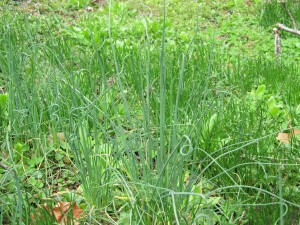Often called “wild onion”, many gardens (including mine) from late winter into spring in eastern Tennessee, western NC and southwest VA are instead plagued by wild garlic (Allium vineale).
Wild garlic forms a rounded blade (stem) while wild onion (A. canadense) has a flattened blade. When freshly cut, the hollow stem of wild garlic is easily visible. Both lawn weeds are edible in a chemical-free lawn and garden. However, chemical herbicides may be your primary option to eliminating both of these noxious weed pests.
Wild garlic forms patches of perennial bulblets which multiply and return each year in greater numbers. Hand pulling is rarely a viable option because the bulblet root system breaks off and sends up a new plant, often within a week. You need to dig and lift beneath the bulbs.
Frequent mowing cuts off flowers to prevent seed head formation. Maintaining a dense stand of lawn grass crowds out wild garlic (and other weeds).
Effective chemical herbicide products include: 2,4-D, Dicamba, Clopyralid, and Triclopyr. Combination herbicides containing two or more of the above products are most effective. Adding a few drops of a spreader/sticker provides better herbicidal action.
This post-emergent treatment also controls white clover, dandelions, ground ivy, thistles, chickweeds, henbits, red sorrel, and wild violets.


 Posted in
Posted in 
